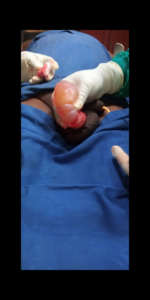
ALTH
_TESTICULAR HYDROCELE_ *CAUSES, SYMPTOMS AND THE MANAGEMENT*
WHAT IS HYDROCELE?
A hydrocele is when fluid fills a male’s scrotum, causing it to swell. It is not a major health issue but it can be embarrassing and uncomfortable. Hydroceles are more common in male infants than adults, and there are treatments to solve the problem.

ALTH
WHAT CAUSES A HYDROCELE?
Towards the end of pregnancy, a male child’s testicles descend from his abdomen into the scrotum. The scrotum is the sac of skin that holds the testicles once they descend.
During development, each testicle has a naturally occurring sac around it that contains fluid. Normally, this sac closes itself and the body absorbs the fluid inside during the baby’s first year. However, this doesn’t happen for babies with a hydrocele. Babies born prematurely are at a higher risk for hydrocele, according to our medical professional at Adebayo living
Hydroceles can also form later in life, mostly in men over 40. This usually occurs if the channel through which the testicles descend hadn’t closed all the way and fluid now enters, or the channel reopens. This can cause fluid to move from the abdomen into the scrotum. Hydroceles can also be caused by inflammation or injury in the scrotum or along the channel. The inflammation may be caused by an infection (epididymitis) or another condition.
WHAT ARE THE SYMPTOMS OF A HYDROCELE?
Hydroceles usually don’t cause any pain. Usually, the only symptom is a swollen scrotum.
In adult men, there may be a feeling of heaviness in the scrotum. In some cases, the swelling might be worse in the morning than in the evening. It is not usually very painful.

ALTH
WHAT ARE THE TYPES OF HYDROCELE?
There are two: communicating hydrocele and non-communicating hydrocele.
*Communicating hydrocele:* This is a type of hydrocele that has contact (communication) with the fluids of the abdominal cavity. A communicating hydrocele is caused by the failure of the processus vaginalis (the thin membrane that extends through the inguinal canal and extends into the scrotum). If this membrane remains open, there is a potential for both a hernia and a hydrocele to develop. The child’s scrotum will appear swollen or large and may change in size throughout the day.
*Non-communicating hydrocele* : In this type, the inguinal canal did close, but there is still extra around the testicle in the scrotum. This condition might be present at birth or might develop years later for no obvious reason. A non-communicating hydrocele usually remains the same size or has very slow growth.
HOW COMMON IS A HYDROCELE?
About 10% of newborn male infants have a hydrocele, which often clears up without any particular treatment within the first year of life. Hydroceles occur in only about 1% of adult men, and will often disappear on their own.

ALTH
CAN A HYDROCELE BE PREVENTED?
NO: There is nothing you can do to prevent your baby from getting a hydrocele. For adolescent and adult men, the best protection against a hydrocele is to keep the testicles and scrotum free of injury.
Although hydroceles are usually not a major health issue, you should visit us at Adebayo living tower hospital about any abnormality or swelling in the scrotum. Another disease or condition may be causing or mimicking the abnormality.
CAN I LIVE A NORMAL LIFE WITH A HYDROCELE?
Yes. A hydrocele shouldn’t interfere with your everyday activities or reduce your quality of life.
WILL A HYDROCELE AFFECT FERTILITY?
NO.

ALTH
WHEN SHOULD I TAKE MY CHILD TO SEE DOCTOR?
Contact us at Adebayo living tower right away if your child is in pain,
And if you notice any of the following in your infant.
These could be signs that part of an intestine has entered the scrotum along with abdominal fluid:
There is a lump in your infant’s scrotum or just above it.
Your infant seems to be having pain.
Your infant seems to be nauseated or is not eating as much as normal.
Your infant is vomiting.
IF MY CHILD NEEDS SURGERY WHAT HAPPENS NEXT?
If your child needs surgery, they will be referred to our medical professional pediatric urologist at Adebayo living tower hospital.
ALTHOUR DIAGNOSIS ON TESTICULAR HYDROCELE
To diagnose a hydrocele, our medical professional at Adebayo living tower hospital will perform a physical examination and also use a testicular ultrasound to obtains the image of the testicles and it’s surrounding area in the scrotum.

ALTH
OUR MEDICAL TREATMENT FOR TESTICULAR HYDROCELE AT ADEBAYO LIVING TOWER HOSPITAL.
A hydrocele usually isn’t painful or harmful and might not need any treatment. But if you have scrota swelling visit our medical professional at Adebayo living tower hospital to rule out other causes.

ALTH
I.C.T department
ADEBAYO LIVING TOWER HOSPITAL ALTH

Recent Comments